Workplace Diversity: Leadership, Management, and Solutions
VerifiedAdded on 2020/04/13
|9
|2222
|48
Homework Assignment
AI Summary
This document provides comprehensive answers to a workplace diversity homework assignment, addressing key aspects of leadership and management within a diverse environment. The solutions cover a wide range of topics, including open communication strategies, qualities of effective role models, and methods for enhancing managerial credibility. The assignment explores different leadership styles (autocratic, democratic, laissez-faire, and paternalistic) and differentiates between long-term and management decision-making processes. It also examines the importance of encouraging positive group behavior, identifying workplace hazards and risks, and providing constructive feedback. Furthermore, the document delves into the importance of ethical behavior, conflict resolution, and the role of communication in fostering a positive work environment. The provided solutions offer practical insights into various aspects of workplace diversity, making it a valuable resource for students studying leadership and management.
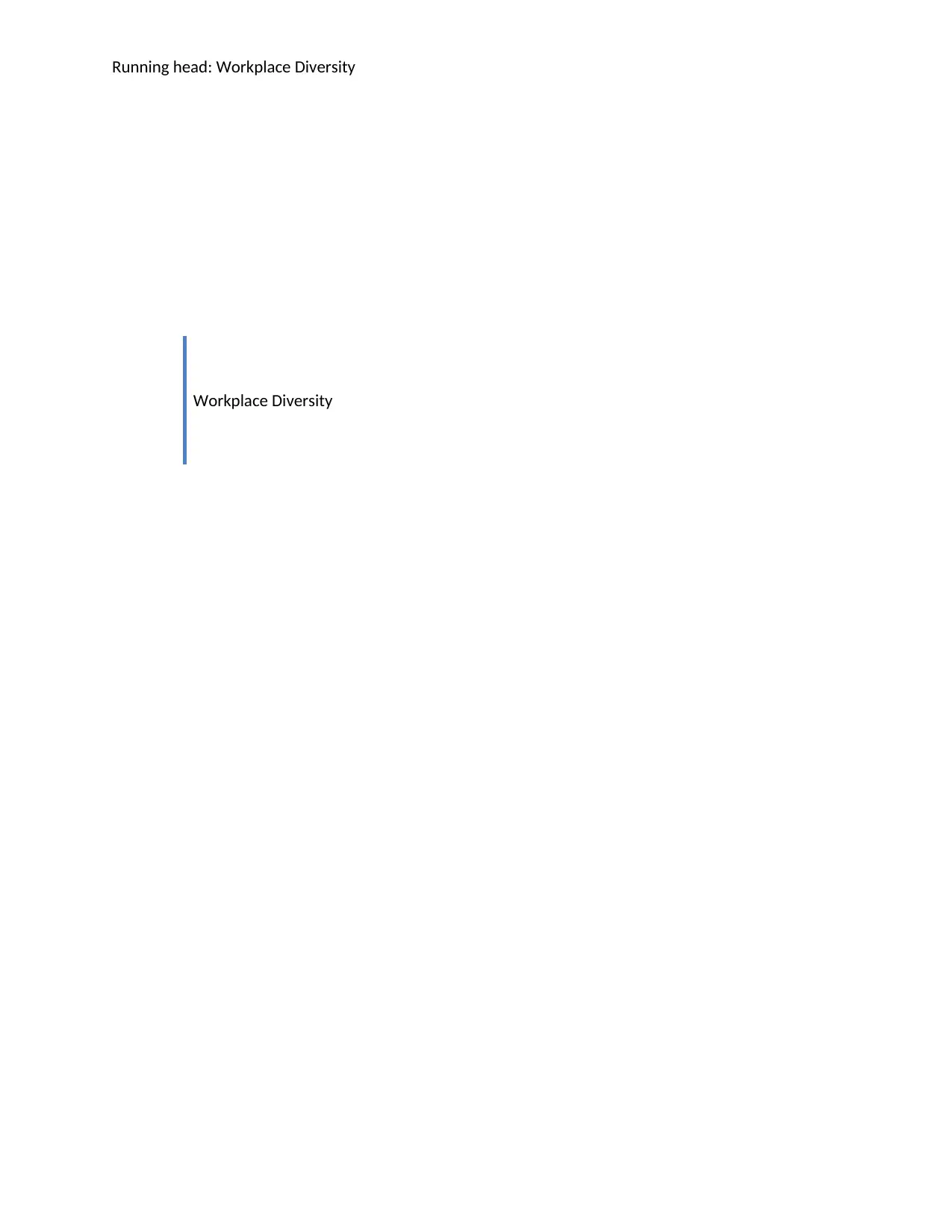
Running head: Workplace Diversity
Workplace Diversity
Workplace Diversity
Paraphrase This Document
Need a fresh take? Get an instant paraphrase of this document with our AI Paraphraser
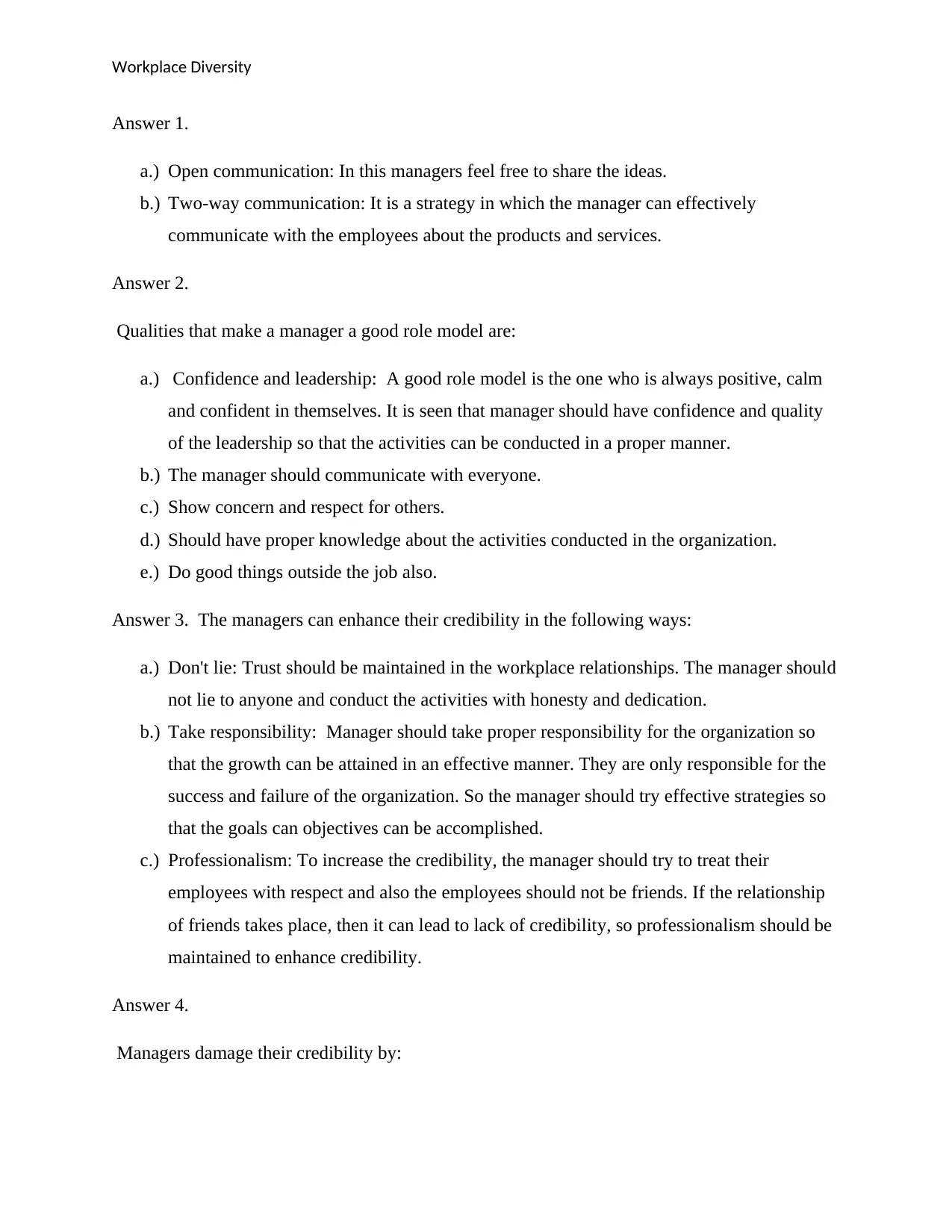
Workplace Diversity
Answer 1.
a.) Open communication: In this managers feel free to share the ideas.
b.) Two-way communication: It is a strategy in which the manager can effectively
communicate with the employees about the products and services.
Answer 2.
Qualities that make a manager a good role model are:
a.) Confidence and leadership: A good role model is the one who is always positive, calm
and confident in themselves. It is seen that manager should have confidence and quality
of the leadership so that the activities can be conducted in a proper manner.
b.) The manager should communicate with everyone.
c.) Show concern and respect for others.
d.) Should have proper knowledge about the activities conducted in the organization.
e.) Do good things outside the job also.
Answer 3. The managers can enhance their credibility in the following ways:
a.) Don't lie: Trust should be maintained in the workplace relationships. The manager should
not lie to anyone and conduct the activities with honesty and dedication.
b.) Take responsibility: Manager should take proper responsibility for the organization so
that the growth can be attained in an effective manner. They are only responsible for the
success and failure of the organization. So the manager should try effective strategies so
that the goals can objectives can be accomplished.
c.) Professionalism: To increase the credibility, the manager should try to treat their
employees with respect and also the employees should not be friends. If the relationship
of friends takes place, then it can lead to lack of credibility, so professionalism should be
maintained to enhance credibility.
Answer 4.
Managers damage their credibility by:
Answer 1.
a.) Open communication: In this managers feel free to share the ideas.
b.) Two-way communication: It is a strategy in which the manager can effectively
communicate with the employees about the products and services.
Answer 2.
Qualities that make a manager a good role model are:
a.) Confidence and leadership: A good role model is the one who is always positive, calm
and confident in themselves. It is seen that manager should have confidence and quality
of the leadership so that the activities can be conducted in a proper manner.
b.) The manager should communicate with everyone.
c.) Show concern and respect for others.
d.) Should have proper knowledge about the activities conducted in the organization.
e.) Do good things outside the job also.
Answer 3. The managers can enhance their credibility in the following ways:
a.) Don't lie: Trust should be maintained in the workplace relationships. The manager should
not lie to anyone and conduct the activities with honesty and dedication.
b.) Take responsibility: Manager should take proper responsibility for the organization so
that the growth can be attained in an effective manner. They are only responsible for the
success and failure of the organization. So the manager should try effective strategies so
that the goals can objectives can be accomplished.
c.) Professionalism: To increase the credibility, the manager should try to treat their
employees with respect and also the employees should not be friends. If the relationship
of friends takes place, then it can lead to lack of credibility, so professionalism should be
maintained to enhance credibility.
Answer 4.
Managers damage their credibility by:
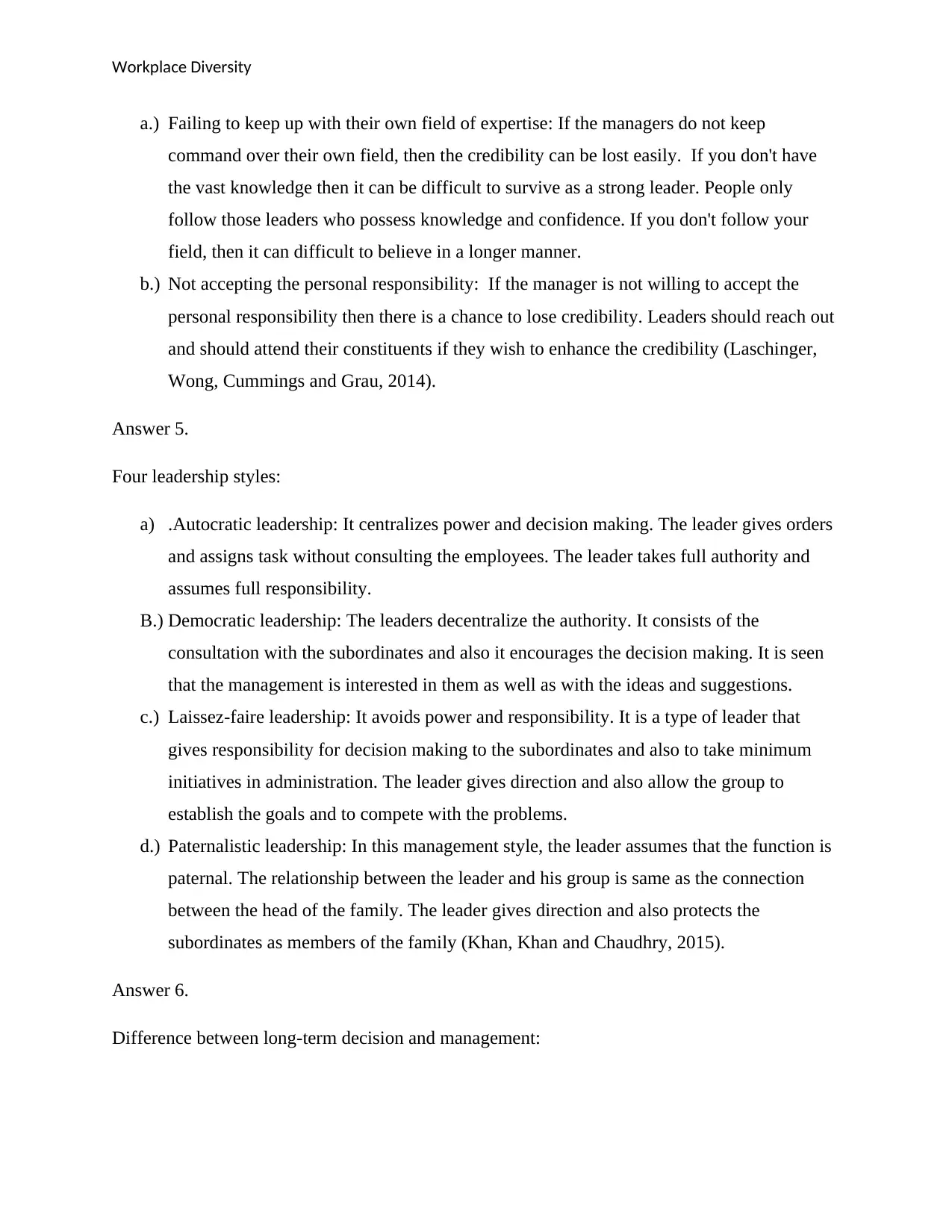
Workplace Diversity
a.) Failing to keep up with their own field of expertise: If the managers do not keep
command over their own field, then the credibility can be lost easily. If you don't have
the vast knowledge then it can be difficult to survive as a strong leader. People only
follow those leaders who possess knowledge and confidence. If you don't follow your
field, then it can difficult to believe in a longer manner.
b.) Not accepting the personal responsibility: If the manager is not willing to accept the
personal responsibility then there is a chance to lose credibility. Leaders should reach out
and should attend their constituents if they wish to enhance the credibility (Laschinger,
Wong, Cummings and Grau, 2014).
Answer 5.
Four leadership styles:
a) .Autocratic leadership: It centralizes power and decision making. The leader gives orders
and assigns task without consulting the employees. The leader takes full authority and
assumes full responsibility.
B.) Democratic leadership: The leaders decentralize the authority. It consists of the
consultation with the subordinates and also it encourages the decision making. It is seen
that the management is interested in them as well as with the ideas and suggestions.
c.) Laissez-faire leadership: It avoids power and responsibility. It is a type of leader that
gives responsibility for decision making to the subordinates and also to take minimum
initiatives in administration. The leader gives direction and also allow the group to
establish the goals and to compete with the problems.
d.) Paternalistic leadership: In this management style, the leader assumes that the function is
paternal. The relationship between the leader and his group is same as the connection
between the head of the family. The leader gives direction and also protects the
subordinates as members of the family (Khan, Khan and Chaudhry, 2015).
Answer 6.
Difference between long-term decision and management:
a.) Failing to keep up with their own field of expertise: If the managers do not keep
command over their own field, then the credibility can be lost easily. If you don't have
the vast knowledge then it can be difficult to survive as a strong leader. People only
follow those leaders who possess knowledge and confidence. If you don't follow your
field, then it can difficult to believe in a longer manner.
b.) Not accepting the personal responsibility: If the manager is not willing to accept the
personal responsibility then there is a chance to lose credibility. Leaders should reach out
and should attend their constituents if they wish to enhance the credibility (Laschinger,
Wong, Cummings and Grau, 2014).
Answer 5.
Four leadership styles:
a) .Autocratic leadership: It centralizes power and decision making. The leader gives orders
and assigns task without consulting the employees. The leader takes full authority and
assumes full responsibility.
B.) Democratic leadership: The leaders decentralize the authority. It consists of the
consultation with the subordinates and also it encourages the decision making. It is seen
that the management is interested in them as well as with the ideas and suggestions.
c.) Laissez-faire leadership: It avoids power and responsibility. It is a type of leader that
gives responsibility for decision making to the subordinates and also to take minimum
initiatives in administration. The leader gives direction and also allow the group to
establish the goals and to compete with the problems.
d.) Paternalistic leadership: In this management style, the leader assumes that the function is
paternal. The relationship between the leader and his group is same as the connection
between the head of the family. The leader gives direction and also protects the
subordinates as members of the family (Khan, Khan and Chaudhry, 2015).
Answer 6.
Difference between long-term decision and management:
⊘ This is a preview!⊘
Do you want full access?
Subscribe today to unlock all pages.

Trusted by 1+ million students worldwide
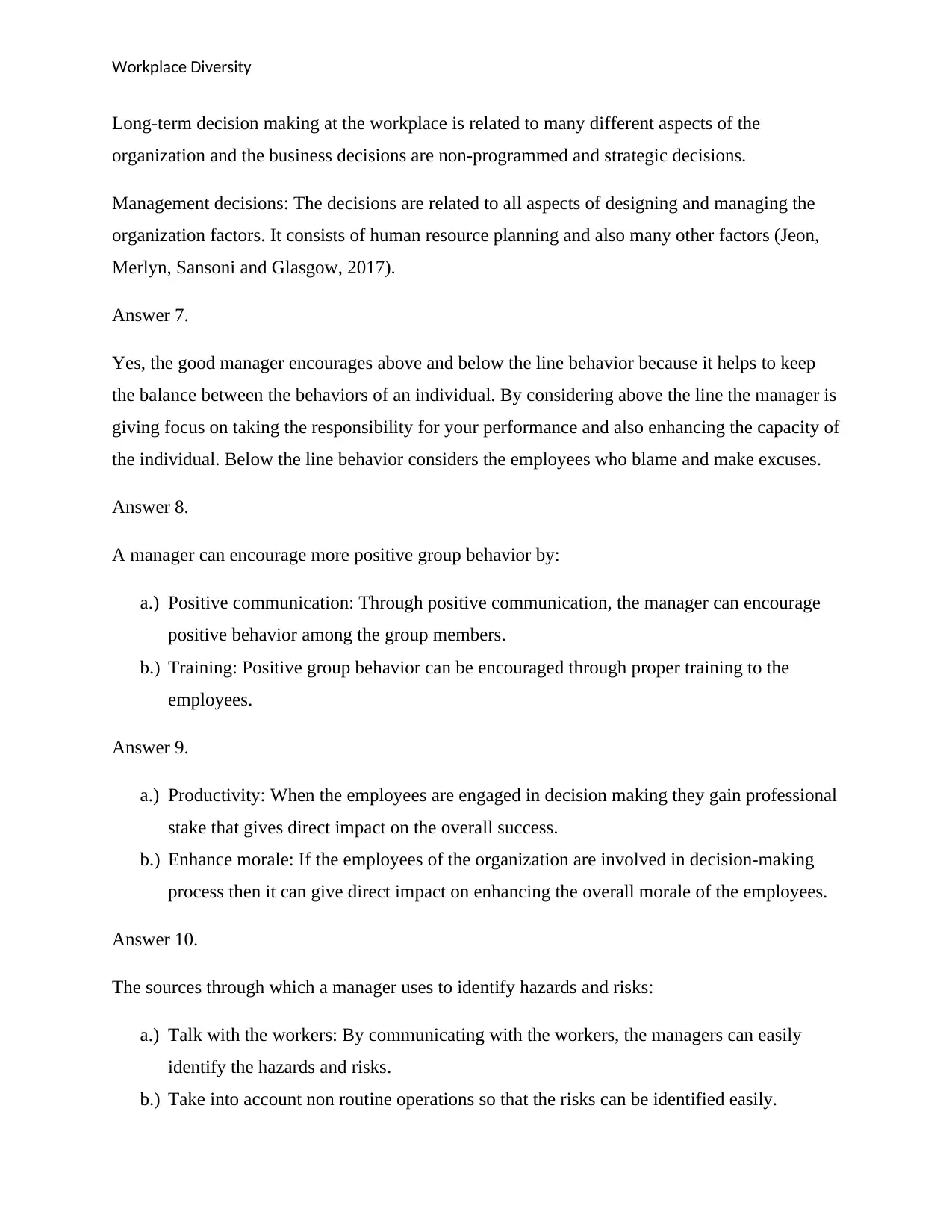
Workplace Diversity
Long-term decision making at the workplace is related to many different aspects of the
organization and the business decisions are non-programmed and strategic decisions.
Management decisions: The decisions are related to all aspects of designing and managing the
organization factors. It consists of human resource planning and also many other factors (Jeon,
Merlyn, Sansoni and Glasgow, 2017).
Answer 7.
Yes, the good manager encourages above and below the line behavior because it helps to keep
the balance between the behaviors of an individual. By considering above the line the manager is
giving focus on taking the responsibility for your performance and also enhancing the capacity of
the individual. Below the line behavior considers the employees who blame and make excuses.
Answer 8.
A manager can encourage more positive group behavior by:
a.) Positive communication: Through positive communication, the manager can encourage
positive behavior among the group members.
b.) Training: Positive group behavior can be encouraged through proper training to the
employees.
Answer 9.
a.) Productivity: When the employees are engaged in decision making they gain professional
stake that gives direct impact on the overall success.
b.) Enhance morale: If the employees of the organization are involved in decision-making
process then it can give direct impact on enhancing the overall morale of the employees.
Answer 10.
The sources through which a manager uses to identify hazards and risks:
a.) Talk with the workers: By communicating with the workers, the managers can easily
identify the hazards and risks.
b.) Take into account non routine operations so that the risks can be identified easily.
Long-term decision making at the workplace is related to many different aspects of the
organization and the business decisions are non-programmed and strategic decisions.
Management decisions: The decisions are related to all aspects of designing and managing the
organization factors. It consists of human resource planning and also many other factors (Jeon,
Merlyn, Sansoni and Glasgow, 2017).
Answer 7.
Yes, the good manager encourages above and below the line behavior because it helps to keep
the balance between the behaviors of an individual. By considering above the line the manager is
giving focus on taking the responsibility for your performance and also enhancing the capacity of
the individual. Below the line behavior considers the employees who blame and make excuses.
Answer 8.
A manager can encourage more positive group behavior by:
a.) Positive communication: Through positive communication, the manager can encourage
positive behavior among the group members.
b.) Training: Positive group behavior can be encouraged through proper training to the
employees.
Answer 9.
a.) Productivity: When the employees are engaged in decision making they gain professional
stake that gives direct impact on the overall success.
b.) Enhance morale: If the employees of the organization are involved in decision-making
process then it can give direct impact on enhancing the overall morale of the employees.
Answer 10.
The sources through which a manager uses to identify hazards and risks:
a.) Talk with the workers: By communicating with the workers, the managers can easily
identify the hazards and risks.
b.) Take into account non routine operations so that the risks can be identified easily.
Paraphrase This Document
Need a fresh take? Get an instant paraphrase of this document with our AI Paraphraser
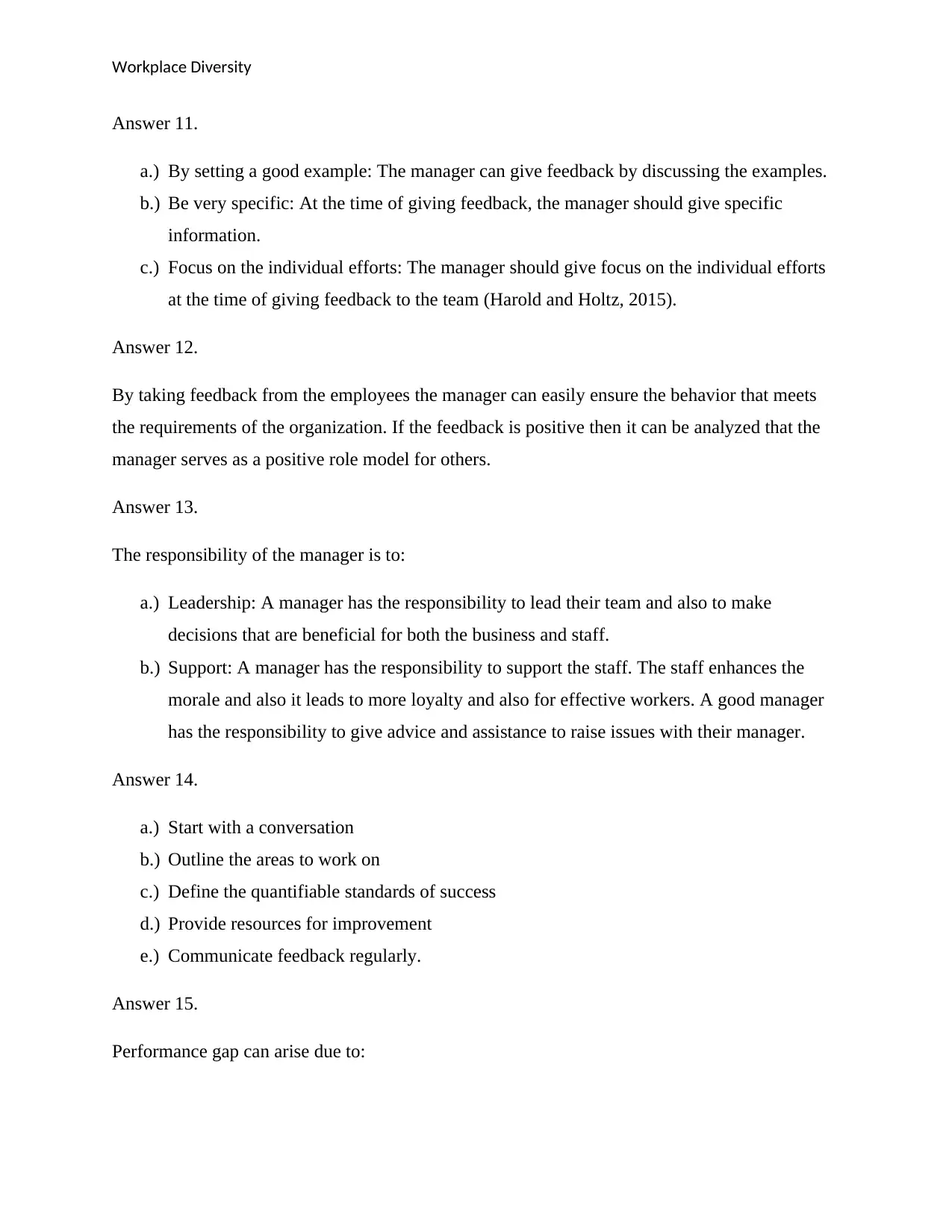
Workplace Diversity
Answer 11.
a.) By setting a good example: The manager can give feedback by discussing the examples.
b.) Be very specific: At the time of giving feedback, the manager should give specific
information.
c.) Focus on the individual efforts: The manager should give focus on the individual efforts
at the time of giving feedback to the team (Harold and Holtz, 2015).
Answer 12.
By taking feedback from the employees the manager can easily ensure the behavior that meets
the requirements of the organization. If the feedback is positive then it can be analyzed that the
manager serves as a positive role model for others.
Answer 13.
The responsibility of the manager is to:
a.) Leadership: A manager has the responsibility to lead their team and also to make
decisions that are beneficial for both the business and staff.
b.) Support: A manager has the responsibility to support the staff. The staff enhances the
morale and also it leads to more loyalty and also for effective workers. A good manager
has the responsibility to give advice and assistance to raise issues with their manager.
Answer 14.
a.) Start with a conversation
b.) Outline the areas to work on
c.) Define the quantifiable standards of success
d.) Provide resources for improvement
e.) Communicate feedback regularly.
Answer 15.
Performance gap can arise due to:
Answer 11.
a.) By setting a good example: The manager can give feedback by discussing the examples.
b.) Be very specific: At the time of giving feedback, the manager should give specific
information.
c.) Focus on the individual efforts: The manager should give focus on the individual efforts
at the time of giving feedback to the team (Harold and Holtz, 2015).
Answer 12.
By taking feedback from the employees the manager can easily ensure the behavior that meets
the requirements of the organization. If the feedback is positive then it can be analyzed that the
manager serves as a positive role model for others.
Answer 13.
The responsibility of the manager is to:
a.) Leadership: A manager has the responsibility to lead their team and also to make
decisions that are beneficial for both the business and staff.
b.) Support: A manager has the responsibility to support the staff. The staff enhances the
morale and also it leads to more loyalty and also for effective workers. A good manager
has the responsibility to give advice and assistance to raise issues with their manager.
Answer 14.
a.) Start with a conversation
b.) Outline the areas to work on
c.) Define the quantifiable standards of success
d.) Provide resources for improvement
e.) Communicate feedback regularly.
Answer 15.
Performance gap can arise due to:
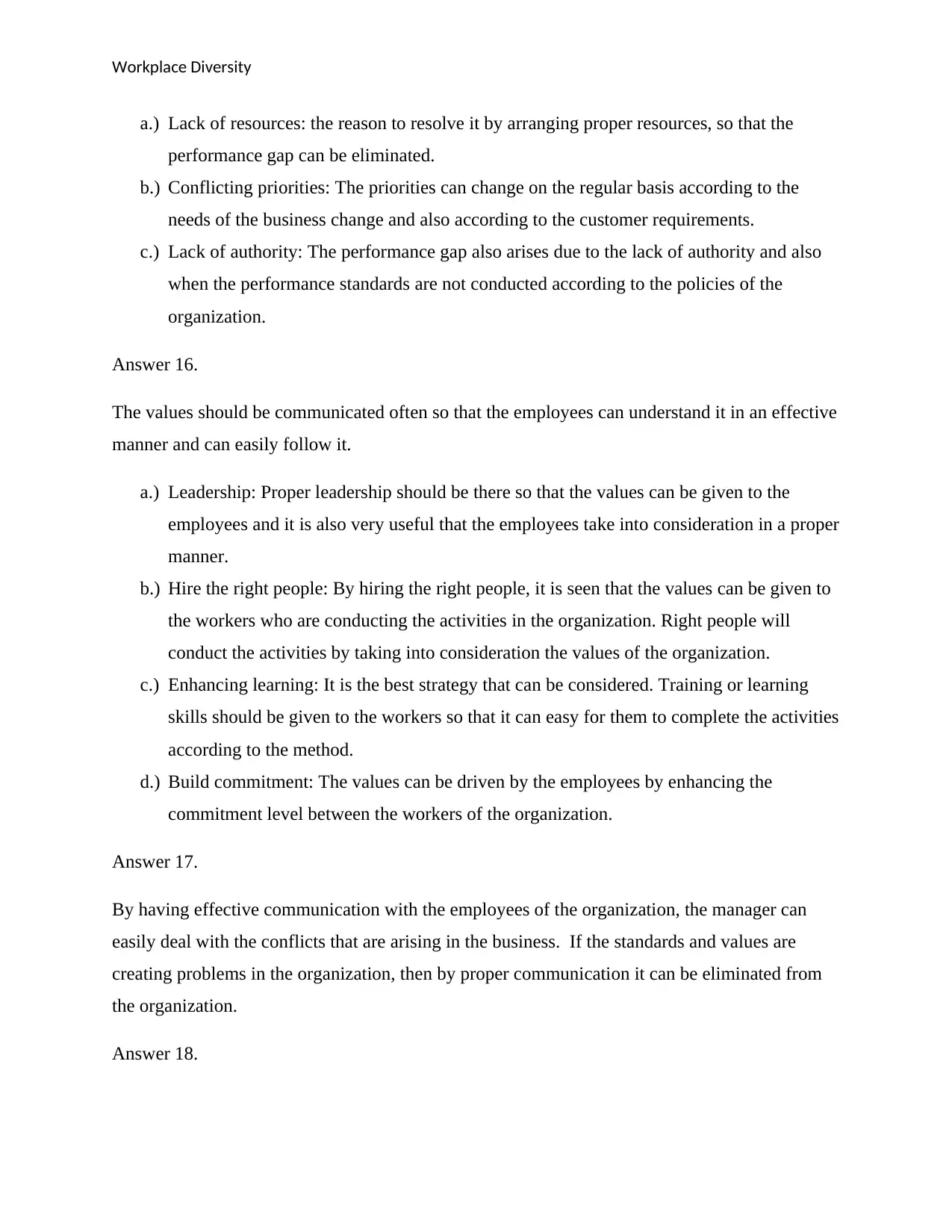
Workplace Diversity
a.) Lack of resources: the reason to resolve it by arranging proper resources, so that the
performance gap can be eliminated.
b.) Conflicting priorities: The priorities can change on the regular basis according to the
needs of the business change and also according to the customer requirements.
c.) Lack of authority: The performance gap also arises due to the lack of authority and also
when the performance standards are not conducted according to the policies of the
organization.
Answer 16.
The values should be communicated often so that the employees can understand it in an effective
manner and can easily follow it.
a.) Leadership: Proper leadership should be there so that the values can be given to the
employees and it is also very useful that the employees take into consideration in a proper
manner.
b.) Hire the right people: By hiring the right people, it is seen that the values can be given to
the workers who are conducting the activities in the organization. Right people will
conduct the activities by taking into consideration the values of the organization.
c.) Enhancing learning: It is the best strategy that can be considered. Training or learning
skills should be given to the workers so that it can easy for them to complete the activities
according to the method.
d.) Build commitment: The values can be driven by the employees by enhancing the
commitment level between the workers of the organization.
Answer 17.
By having effective communication with the employees of the organization, the manager can
easily deal with the conflicts that are arising in the business. If the standards and values are
creating problems in the organization, then by proper communication it can be eliminated from
the organization.
Answer 18.
a.) Lack of resources: the reason to resolve it by arranging proper resources, so that the
performance gap can be eliminated.
b.) Conflicting priorities: The priorities can change on the regular basis according to the
needs of the business change and also according to the customer requirements.
c.) Lack of authority: The performance gap also arises due to the lack of authority and also
when the performance standards are not conducted according to the policies of the
organization.
Answer 16.
The values should be communicated often so that the employees can understand it in an effective
manner and can easily follow it.
a.) Leadership: Proper leadership should be there so that the values can be given to the
employees and it is also very useful that the employees take into consideration in a proper
manner.
b.) Hire the right people: By hiring the right people, it is seen that the values can be given to
the workers who are conducting the activities in the organization. Right people will
conduct the activities by taking into consideration the values of the organization.
c.) Enhancing learning: It is the best strategy that can be considered. Training or learning
skills should be given to the workers so that it can easy for them to complete the activities
according to the method.
d.) Build commitment: The values can be driven by the employees by enhancing the
commitment level between the workers of the organization.
Answer 17.
By having effective communication with the employees of the organization, the manager can
easily deal with the conflicts that are arising in the business. If the standards and values are
creating problems in the organization, then by proper communication it can be eliminated from
the organization.
Answer 18.
⊘ This is a preview!⊘
Do you want full access?
Subscribe today to unlock all pages.

Trusted by 1+ million students worldwide
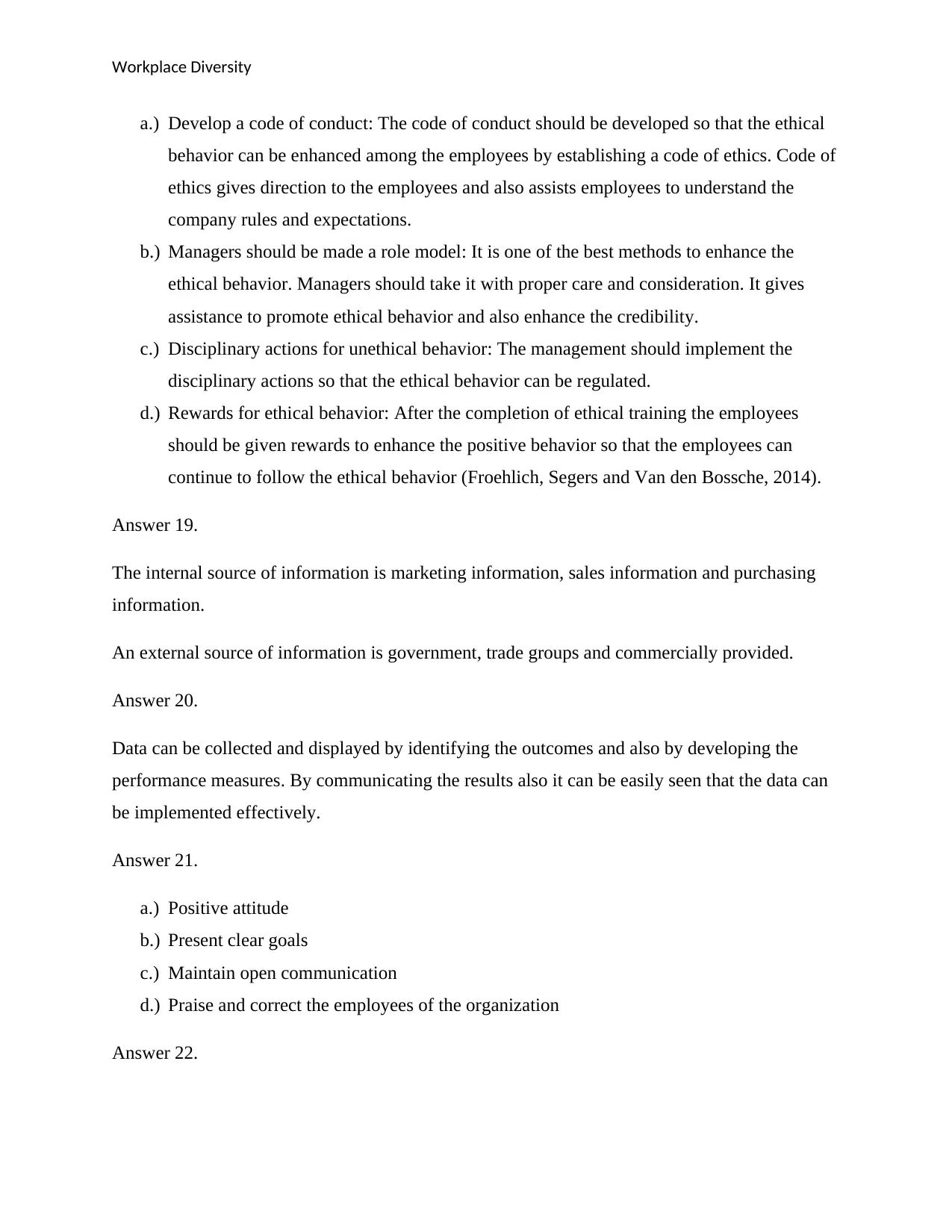
Workplace Diversity
a.) Develop a code of conduct: The code of conduct should be developed so that the ethical
behavior can be enhanced among the employees by establishing a code of ethics. Code of
ethics gives direction to the employees and also assists employees to understand the
company rules and expectations.
b.) Managers should be made a role model: It is one of the best methods to enhance the
ethical behavior. Managers should take it with proper care and consideration. It gives
assistance to promote ethical behavior and also enhance the credibility.
c.) Disciplinary actions for unethical behavior: The management should implement the
disciplinary actions so that the ethical behavior can be regulated.
d.) Rewards for ethical behavior: After the completion of ethical training the employees
should be given rewards to enhance the positive behavior so that the employees can
continue to follow the ethical behavior (Froehlich, Segers and Van den Bossche, 2014).
Answer 19.
The internal source of information is marketing information, sales information and purchasing
information.
An external source of information is government, trade groups and commercially provided.
Answer 20.
Data can be collected and displayed by identifying the outcomes and also by developing the
performance measures. By communicating the results also it can be easily seen that the data can
be implemented effectively.
Answer 21.
a.) Positive attitude
b.) Present clear goals
c.) Maintain open communication
d.) Praise and correct the employees of the organization
Answer 22.
a.) Develop a code of conduct: The code of conduct should be developed so that the ethical
behavior can be enhanced among the employees by establishing a code of ethics. Code of
ethics gives direction to the employees and also assists employees to understand the
company rules and expectations.
b.) Managers should be made a role model: It is one of the best methods to enhance the
ethical behavior. Managers should take it with proper care and consideration. It gives
assistance to promote ethical behavior and also enhance the credibility.
c.) Disciplinary actions for unethical behavior: The management should implement the
disciplinary actions so that the ethical behavior can be regulated.
d.) Rewards for ethical behavior: After the completion of ethical training the employees
should be given rewards to enhance the positive behavior so that the employees can
continue to follow the ethical behavior (Froehlich, Segers and Van den Bossche, 2014).
Answer 19.
The internal source of information is marketing information, sales information and purchasing
information.
An external source of information is government, trade groups and commercially provided.
Answer 20.
Data can be collected and displayed by identifying the outcomes and also by developing the
performance measures. By communicating the results also it can be easily seen that the data can
be implemented effectively.
Answer 21.
a.) Positive attitude
b.) Present clear goals
c.) Maintain open communication
d.) Praise and correct the employees of the organization
Answer 22.
Paraphrase This Document
Need a fresh take? Get an instant paraphrase of this document with our AI Paraphraser
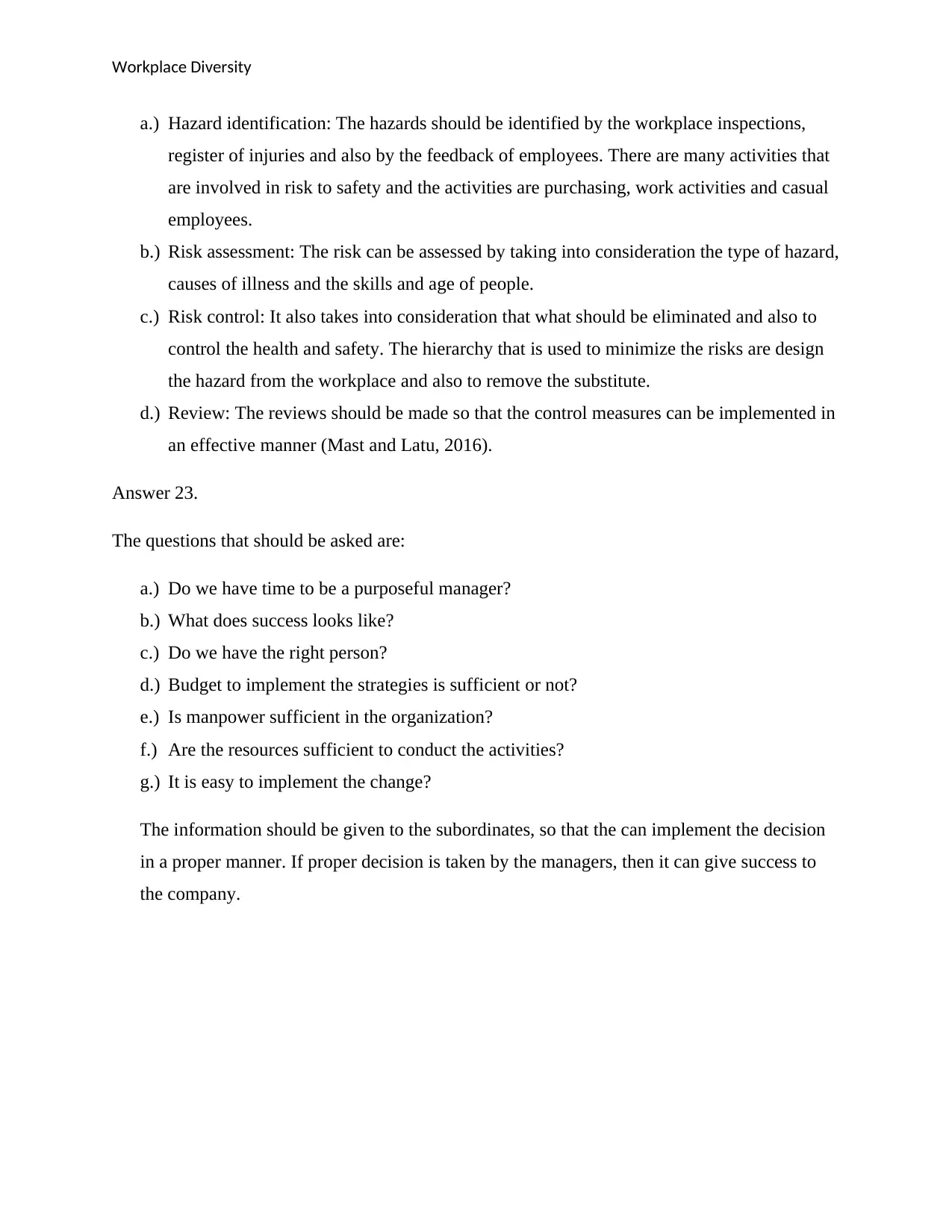
Workplace Diversity
a.) Hazard identification: The hazards should be identified by the workplace inspections,
register of injuries and also by the feedback of employees. There are many activities that
are involved in risk to safety and the activities are purchasing, work activities and casual
employees.
b.) Risk assessment: The risk can be assessed by taking into consideration the type of hazard,
causes of illness and the skills and age of people.
c.) Risk control: It also takes into consideration that what should be eliminated and also to
control the health and safety. The hierarchy that is used to minimize the risks are design
the hazard from the workplace and also to remove the substitute.
d.) Review: The reviews should be made so that the control measures can be implemented in
an effective manner (Mast and Latu, 2016).
Answer 23.
The questions that should be asked are:
a.) Do we have time to be a purposeful manager?
b.) What does success looks like?
c.) Do we have the right person?
d.) Budget to implement the strategies is sufficient or not?
e.) Is manpower sufficient in the organization?
f.) Are the resources sufficient to conduct the activities?
g.) It is easy to implement the change?
The information should be given to the subordinates, so that the can implement the decision
in a proper manner. If proper decision is taken by the managers, then it can give success to
the company.
a.) Hazard identification: The hazards should be identified by the workplace inspections,
register of injuries and also by the feedback of employees. There are many activities that
are involved in risk to safety and the activities are purchasing, work activities and casual
employees.
b.) Risk assessment: The risk can be assessed by taking into consideration the type of hazard,
causes of illness and the skills and age of people.
c.) Risk control: It also takes into consideration that what should be eliminated and also to
control the health and safety. The hierarchy that is used to minimize the risks are design
the hazard from the workplace and also to remove the substitute.
d.) Review: The reviews should be made so that the control measures can be implemented in
an effective manner (Mast and Latu, 2016).
Answer 23.
The questions that should be asked are:
a.) Do we have time to be a purposeful manager?
b.) What does success looks like?
c.) Do we have the right person?
d.) Budget to implement the strategies is sufficient or not?
e.) Is manpower sufficient in the organization?
f.) Are the resources sufficient to conduct the activities?
g.) It is easy to implement the change?
The information should be given to the subordinates, so that the can implement the decision
in a proper manner. If proper decision is taken by the managers, then it can give success to
the company.
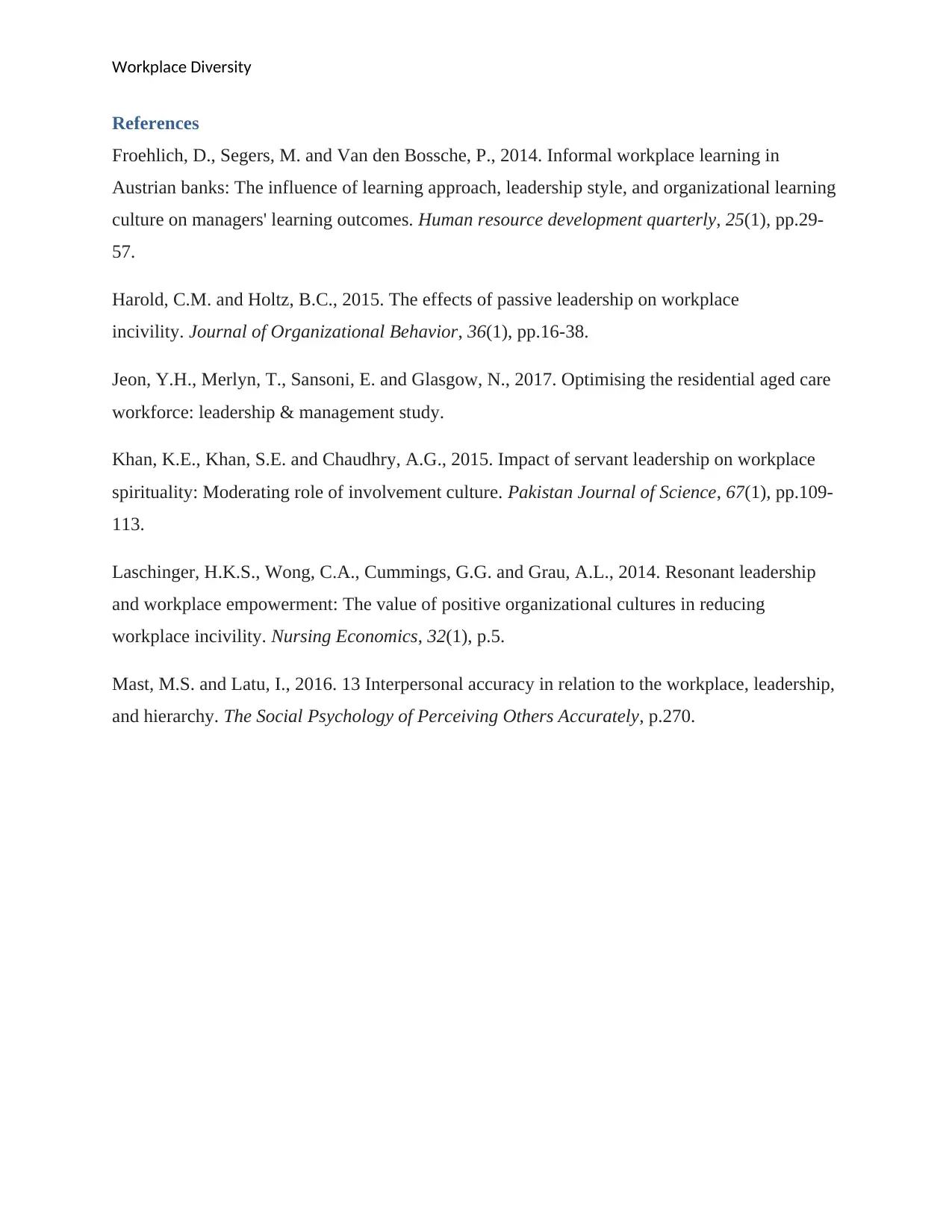
Workplace Diversity
References
Froehlich, D., Segers, M. and Van den Bossche, P., 2014. Informal workplace learning in
Austrian banks: The influence of learning approach, leadership style, and organizational learning
culture on managers' learning outcomes. Human resource development quarterly, 25(1), pp.29-
57.
Harold, C.M. and Holtz, B.C., 2015. The effects of passive leadership on workplace
incivility. Journal of Organizational Behavior, 36(1), pp.16-38.
Jeon, Y.H., Merlyn, T., Sansoni, E. and Glasgow, N., 2017. Optimising the residential aged care
workforce: leadership & management study.
Khan, K.E., Khan, S.E. and Chaudhry, A.G., 2015. Impact of servant leadership on workplace
spirituality: Moderating role of involvement culture. Pakistan Journal of Science, 67(1), pp.109-
113.
Laschinger, H.K.S., Wong, C.A., Cummings, G.G. and Grau, A.L., 2014. Resonant leadership
and workplace empowerment: The value of positive organizational cultures in reducing
workplace incivility. Nursing Economics, 32(1), p.5.
Mast, M.S. and Latu, I., 2016. 13 Interpersonal accuracy in relation to the workplace, leadership,
and hierarchy. The Social Psychology of Perceiving Others Accurately, p.270.
References
Froehlich, D., Segers, M. and Van den Bossche, P., 2014. Informal workplace learning in
Austrian banks: The influence of learning approach, leadership style, and organizational learning
culture on managers' learning outcomes. Human resource development quarterly, 25(1), pp.29-
57.
Harold, C.M. and Holtz, B.C., 2015. The effects of passive leadership on workplace
incivility. Journal of Organizational Behavior, 36(1), pp.16-38.
Jeon, Y.H., Merlyn, T., Sansoni, E. and Glasgow, N., 2017. Optimising the residential aged care
workforce: leadership & management study.
Khan, K.E., Khan, S.E. and Chaudhry, A.G., 2015. Impact of servant leadership on workplace
spirituality: Moderating role of involvement culture. Pakistan Journal of Science, 67(1), pp.109-
113.
Laschinger, H.K.S., Wong, C.A., Cummings, G.G. and Grau, A.L., 2014. Resonant leadership
and workplace empowerment: The value of positive organizational cultures in reducing
workplace incivility. Nursing Economics, 32(1), p.5.
Mast, M.S. and Latu, I., 2016. 13 Interpersonal accuracy in relation to the workplace, leadership,
and hierarchy. The Social Psychology of Perceiving Others Accurately, p.270.
⊘ This is a preview!⊘
Do you want full access?
Subscribe today to unlock all pages.

Trusted by 1+ million students worldwide
1 out of 9
Related Documents
Your All-in-One AI-Powered Toolkit for Academic Success.
+13062052269
info@desklib.com
Available 24*7 on WhatsApp / Email
![[object Object]](/_next/static/media/star-bottom.7253800d.svg)
Unlock your academic potential
Copyright © 2020–2025 A2Z Services. All Rights Reserved. Developed and managed by ZUCOL.




